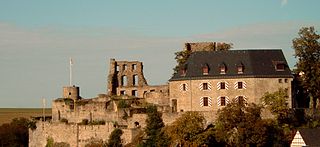History
The castle is first recorded in 1130 when Count Emicho of Schmidburg bequeathed it to Gerlach I of Veldenz. When Frederick III, Count of Veldenz died in 1444, the male line of the counts of Veldenz died out with him. The castle and the County of Veldenz (as well as a portion of the County of Sponheim) went to his son-in-law, Stephen, Count Palatine of Simmern-Zweibrücken. Stephen divided these holdings that same year, assigning the castle and Veldenz to his younger son, Louis I, Count Palatine of Zweibrücken. Louis expanded the castle into a strong fortress. The castle suffered serious damage during the Thirty Years' War; it was transferred to the Spanish in 1620 and was taken over by Croats in 1622. In 1631, the Swedes entered the castle and used it as a barracks. In 1689 the castle was destroyed during the War of the Palatine Succession by the troops of King Louis XIV. Its ruins were returned to their original owner in 1693. During the French Revolution the castle was seized as 'national property'.
The most comprehensive maintenance and renovation work since the destruction of the castle took place in 1977 and 1978. A few years later, from 1981 to 1983, a refuge hut was built over the cellar vaulting.
The castle belongs today to the town of Obermoschel which, since 2005, has undertaken annual maintenance and improvement work. In 2007, parts of the castle site were planted with old species of rose and the meadow was planted with fruit trees.

Lauterecken is a town in the Kusel district in Rhineland-Palatinate, Germany. It is the seat of the Verbandsgemeinde Lauterecken-Wolfstein, to which it also belongs. Lauterecken bears the nickname Veldenzstadt, after the comital family that once held sway here. It is also a state-recognized tourism resort town, and in terms of state planning is laid out as a lower centre.

Stephen of Simmern-Zweibrücken was Count Palatine of Simmern and Zweibrücken from 1410 until his death in 1459.

The Duchy of Palatinate-Zweibrücken was a duchy of the Holy Roman Empire with full voting rights to the Reichstag. Its capital was Zweibrücken. The reigning house, a branch of the Wittelsbach dynasty, was also the Royal House of Sweden from 1654 to 1720.

The County Palatine of Veldenz was a principality in the contemporary Land Rhineland-Palatinate with full voting rights to the Reichstag. The county was located partially between Kaiserslautern, Sponheim and Zweibrücken, partially on the Mosel in the Archbishopric of Trier. A municipality of the same name, Veldenz, and a castle, Schloss Veldenz, are located in the district of Bernkastel-Wittlich.

Louis I of Zweibrücken was Count Palatine and Duke of Zweibrücken and Count of Veldenz from 1444 until his death in 1489.

Obermoschel is a town and municipality in the district Donnersbergkreis, Rhineland-Palatinate, Germany. With around 1,000 residents, it is the smallest town in the Palatinate (Pfalz). It is part of the Verbandsgemeinde Nordpfälzer Land, which has its seat of administration in community of Rockenhausen and an administrative office in Alsenz. According to regional planning, Obermoschel is designated as lower-order center (Grundzentrum).

Frederick Casimir was the Duke of Landsberg from 1604 until 1645.

Frederick Louis was the Duke of Landsberg from 1645 until 1681, and the Count Palatine of Zweibrücken from 1661 until 1681.

Veldenz is an Ortsgemeinde – a municipality belonging to a Verbandsgemeinde, a kind of collective municipality – in the Bernkastel-Wittlich district in Rhineland-Palatinate, Germany. It is the former main seat of the County of Veldenz, once a prominent principality to which belonged 120 villages and towns now in Rhineland-Palatinate and northern Alsace and Lorraine.

Haschbach am Remigiusberg is an Ortsgemeinde – a municipality belonging to a Verbandsgemeinde, a kind of collective municipality – in the Kusel district in Rhineland-Palatinate, Germany. It belongs to the Verbandsgemeinde of Kusel-Altenglan, whose seat is in Kusel.

Heinzenhausen on the Lauter is an Ortsgemeinde – a municipality belonging to a Verbandsgemeinde, a kind of collective municipality – in the Kusel district in Rhineland-Palatinate, Germany. It belongs to the Verbandsgemeinde of Lauterecken-Wolfstein.

Lohnweiler is an Ortsgemeinde – a municipality belonging to a Verbandsgemeinde, a kind of collective municipality – in the Kusel district in Rhineland-Palatinate, Germany. It belongs to the Verbandsgemeinde Lauterecken-Wolfstein.

La Petite-Pierre is a commune in the Bas-Rhin department in Grand Est in north-eastern France. It lies in the historical and cultural region of Alsace. Petit-Pierre literally means little rock.

Schloss Veldenz in the Hunsrück upland, on a steep vale draining into the Mosel is a castle ruin about 1.5 kilometres (0.9 mi) southeast of the village of Veldenz in the German state of Rhineland-Palatinate.

The County of Sponheim was an independent territory in the Holy Roman Empire that lasted from the 11th century until the early 19th century. The name comes from the municipality of Sponheim, where the counts had their original residence.
Palatinate-Landsberg was a state of the Holy Roman Empire based around Landsberg Castle near Obermoschel, in southwestern Germany.

Kastellaun Castle is a ruined medieval castle in Kastellaun in the Rhein-Hunsrück district in Rhineland-Palatinate, Germany.

Veldenz Castle was built on a spur above the village of Nohfelden in Landkreis Sankt Wendel in the northeast of Saarland, Germany.

Lemberg Castle is a medieval castle on the territory of Lemberg in the county of Südwestpfalz in the German state of Rhineland-Palatinate.

The Veldenz Schloss of Lauterecken stands in the little Palatine town of Lauterecken and is a cultural monument. It was once the residence of the counts of Palatinate-Veldenz, who lived for four generations that lasted for 151. The schloss is at Veldenzplatz 1. Since 2017 it has been converted and renovated internally in order to become a new 'jewel' for the town of Lauterecken.
This page is based on this
Wikipedia article Text is available under the
CC BY-SA 4.0 license; additional terms may apply.
Images, videos and audio are available under their respective licenses.





















